What makes a Premier Gear Award winner—particularly when about 90 percent of the gear we saw this year could be considered for the distinction? Well, above all, what it really means is that a guitar, bass, pedal, or amp spoke to the reviewer in a deeply personal way and opened up a sense of possibility or an avenue of expression. It means that, somewhere, a manufacturer, designer, garage-based pedal builder, or sawdust-churning luthier has applied their talents to create something extraordinary by any measure.
But perhaps most important, each of these tools spoke up in their own voice and said, “There is music within these wires, wood, and circuits. Come! Take it and make it yours!” We’re quite certain you’ll find your own tune lurking in one of these objects, however beastly, beautiful, or bizarre. We can’t wait to hear what you come up with.
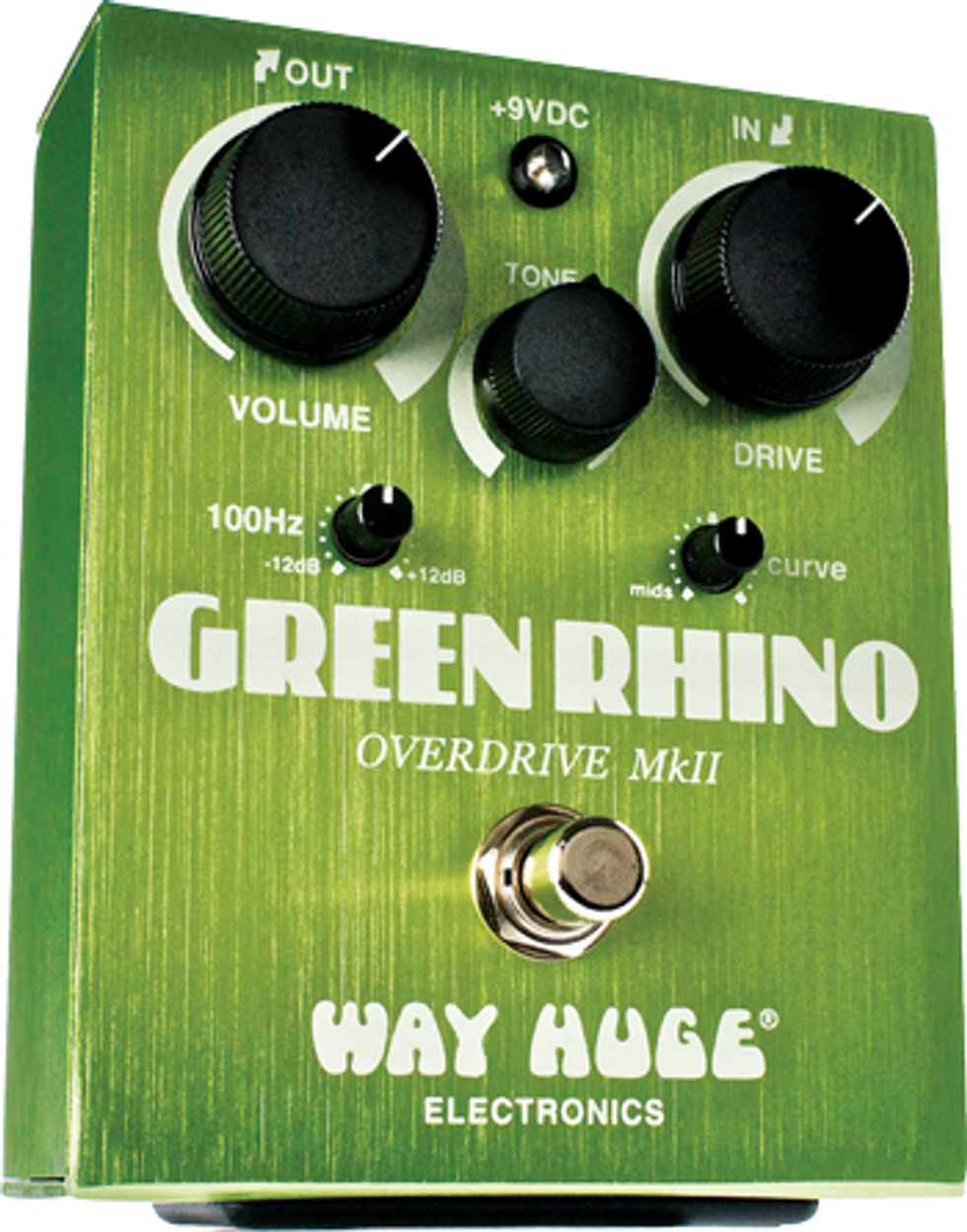
WAY HUGE
GREEN RHINO
OVERDRIVE
MKII
In its original incarnation, the Way Huge
Green Rhino was one of those effects that,
in the eyes and ears of some players, grew
to be more adored than its inspiration. Way
Huge’s take on the TS-808 was never built
in large numbers but it was treasured for
taking the Tube Screamer tone template and
widening its sonic spectrum.
We gave this reissue a Premier Gear Award because it so beautifully manages to pull the same trick twice. As we noted in our original review, the Green Rhino jumps off from the bluesy, thick tone made popular by the Tube Screamer and adds a little more clarity, low end, and bite.
Reviewer Jordan Wagner praised it for “delivering gritty, vintage blues tones with a little extra width and clarity.” He also noted that the “100 Hz boost/cut control is capable of transforming the Green Rhino from a blues lead powerhouse into a gutsy, standalone overdrive that preserves pick dynamics for everything from 16th-note riffage to Stonesy rhythm work.” It’s enough to make us scream, “Welcome back Rhino!”
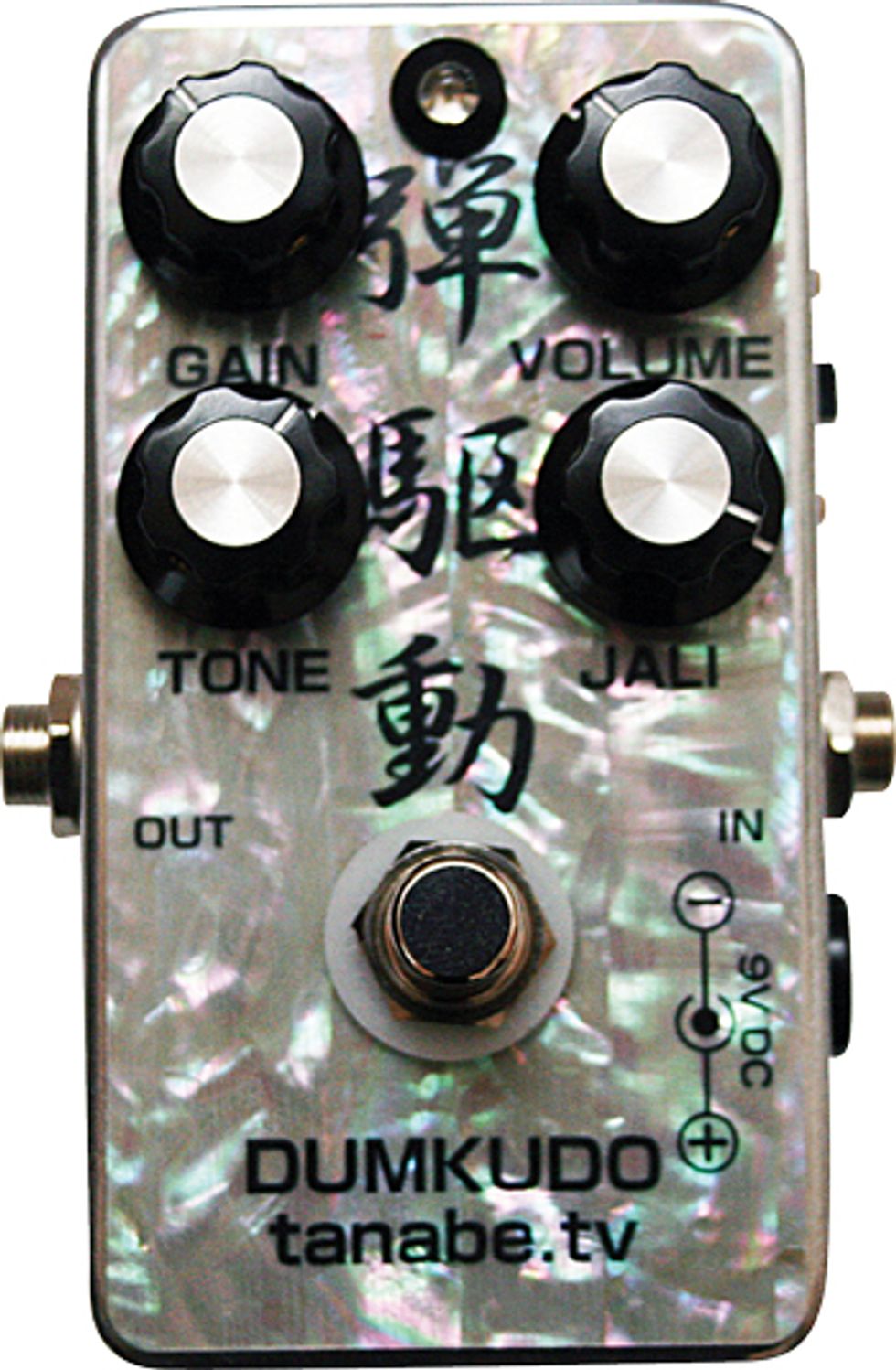
DUMKUDO
OVERDRIVE
When we first heard about the Dumkudo
Overdrive, it was in hushed whispers of
a “Dumble in a box.” As it turns out, the
Dunkudo Overdrive is much more than
that. Gear Editor Charles Saufley declared
that it’s “one of those seemingly living,
breathing pieces of musical gear that will
talk back to you, point you down a different
path, and holler encouragement. Or
give you just what you need when you want
to play it safe and speak up within your
comfort zone.”
PG found that the three switchable voices give the Dumkudo a flexibility that’s “bound to appeal to everyone from blues and roots-rock players that like a little more horsepower under the hood to jazzers willing to dabble with more impolite tones.” The Dunkudo can move from mellow to menacing at the drop of a hat—and it looks pretty freaking cool doing it, too.
GOODSELL
VALPREAUX 21
We were onboard the minute we heard that
Richard Goodsell was building an amp
powered by 6973 tubes—the tube of choice
behind many low-to-mid-powered 1960s
Valco, Supro, and Gretsch amp circuits. We
also knew that in the hands of Goodsell it
would become something very special all on
its own.
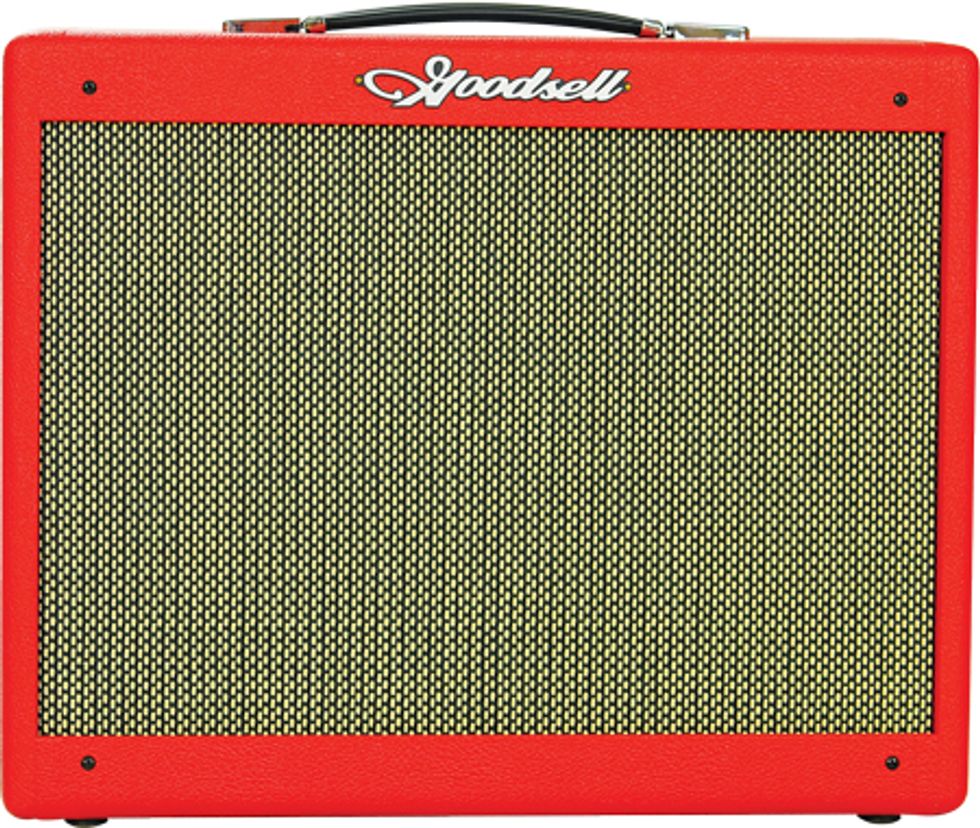
Editor in Chief Shawn Hammond dug the wide range of tones, from the fat and slightly scooped Wes Montgomery sounds to the bright, biting, and twangy textures. But he was bowled over by the tremolo, remarking “I’ve never encountered a warble that sounded so fat and three-dimensional… at about 10 o’clock and Depth cranked—it was like Hendrix playing “Machine Gun” through a Leslie!”
We’re used to Richard Goodsell building great stuff. It was especially nice to see him venture out from the tried and true templates this time around—and with such spectacular results.

EASTWOOD
GUITARS
WARREN ELLIS
SIGNATURE
TENOR
Nick Cave sideman and Grinderman multiinstrumentalist
Warren Ellis may not seem
like the most likely candidate for a signature
axe—heck, he spends half his time playing
fiddle. But anyone who witnessed
Warren the Wizard conjure everything from
sweet jangle to hellhound howls from his
Eastwood tenor on the last Grinderman tour
could will understand the massive potential
of both Ellis and this cool, little guitar.
PG Gear Editor Charles Saufley found that “the string spacing makes fingerpicking this thing a delight. And adapting clawhammer banjo techniques to electric guitar tones resulted in some very interesting approaches to both composition and cool-sounding versions of old folk and country standards.”
And while it’s two strings shy of what most of us would consider a full house, he also found the Eastwood to be a guitar of “remarkable versatility—one that can lend thrilling new flavors to roots music, Americana, and internationally flavored jams, as well as worlds of texture to the music of boundary-obliterating experimentalists.” Trust us, you’ll never think of four strings the same!
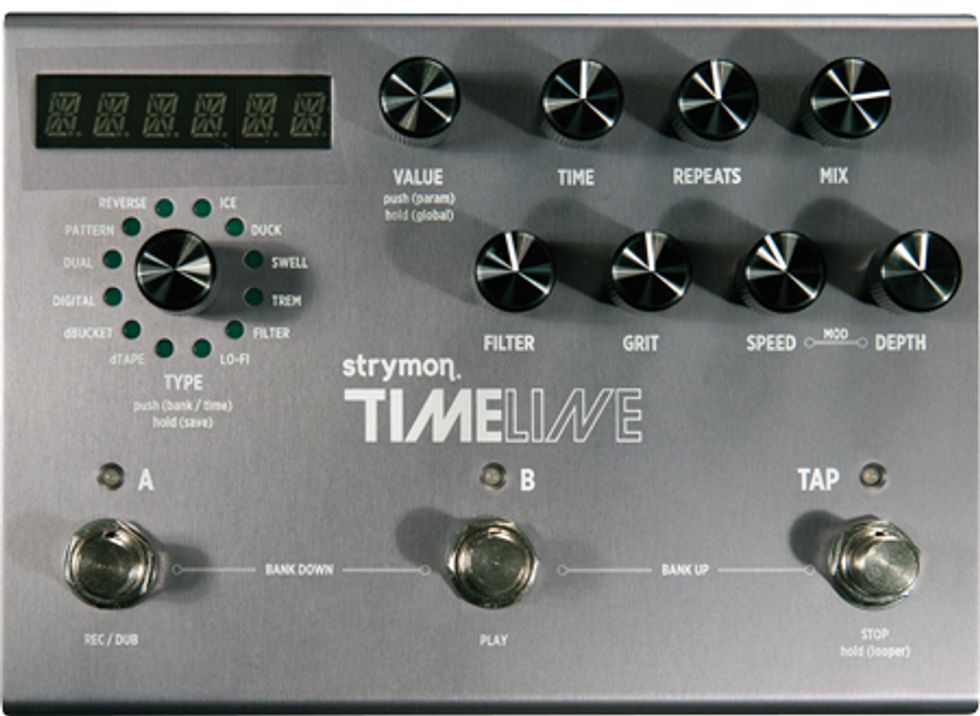
STRYMON
TIMELINE
At this point, we could probably call
Strymon relentless. This mad scientists’ club
of tone-tweaking kooks keeps obliterating
expectations about how analog digital signal
processing can sound. But they’re also happy
to exploit digital’s potential to explore more
exotic sounds and analog emulations in the
same unit. And that breadth of vision births
wonders like the TimeLine, a studio-grade
Delay that leaves few permutations of the
effect unexplored in a package that’s surprisingly
easy to navigate.
Strymon’s amazing tape delay emulation technology is just one of the delay options on a menu that runs from analog delay staples to super-out-there intergalactic textures. It’s full of cool preset capabilities, filters, and modulation for coloring your repeats. It also has an all-around, can-do aura that we found “infinitely tweakable to suit a musical situation.” This is one tough-to-top delay.
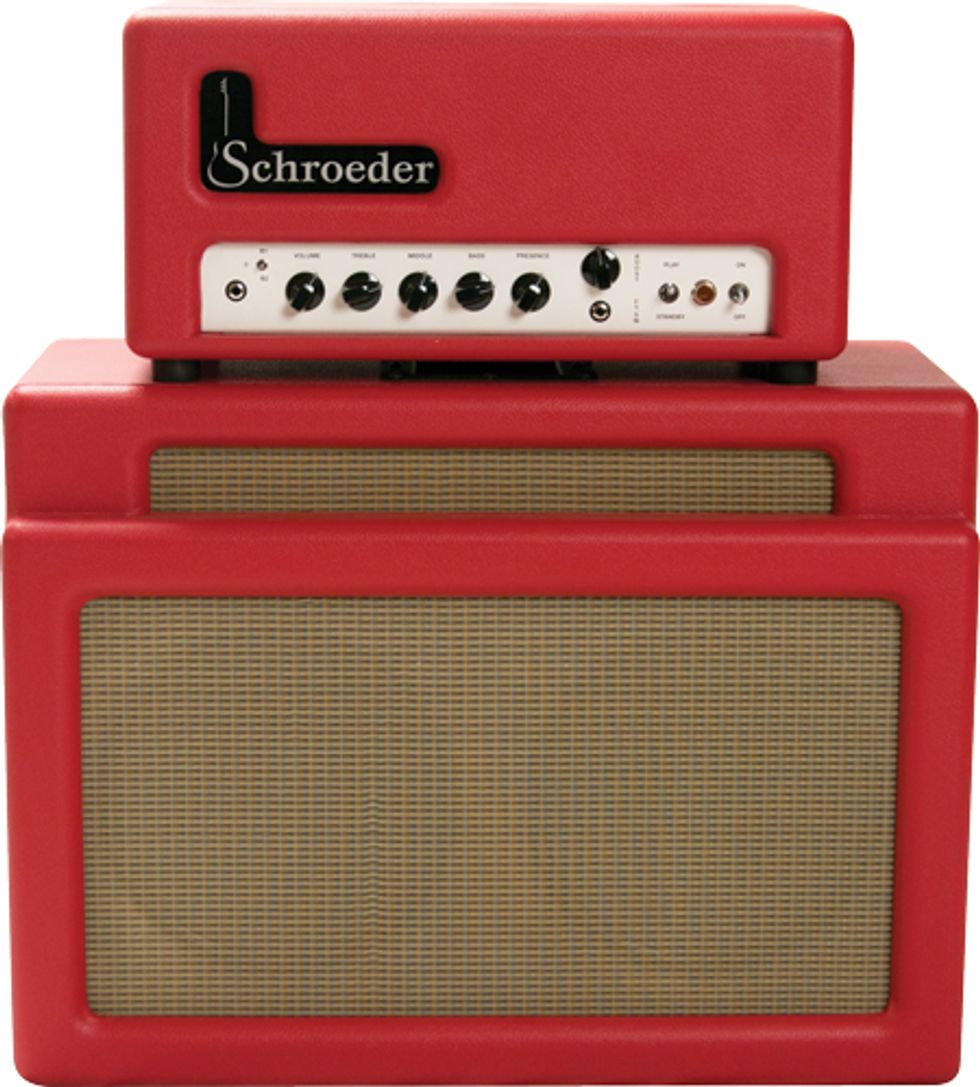
SCHROEDER
AUDIO DB7
Chicago amp wiz Tim Schroeder is good
enough to win the favor of noted gear junkies
Jeff Tweedy and Wilco. And these days,
that means you also have the ear of otherwordly
axe genius Nels Cline. The DB7
is essentially the same amp that Schroeder
built for Cline—one that’s since become
his main squeeze onstage because it satisfies
the sonic alchemist’s need for wide sonic
spectrum and sky-high headroom in a midpower
amp.
Reviewer Adam Perlmutter found the 6L6-powered, 45-watt DB7 to be “a sustain machine, making the plainest of sonorities a thing of wonder.” He remarked that the “simple act of hitting a first-position chord on the guitar summoned a tone that was uncommonly full-bodied, sweet, and complex.” Perlmutter was also knocked out by it’s beauty, quality, and brilliant design. And if we heard a nicer amp this year, quite honestly we can’t remember anymore—we still hear the sweet chime of the DB7 ringing in our ears.
schroederaudioinc.com
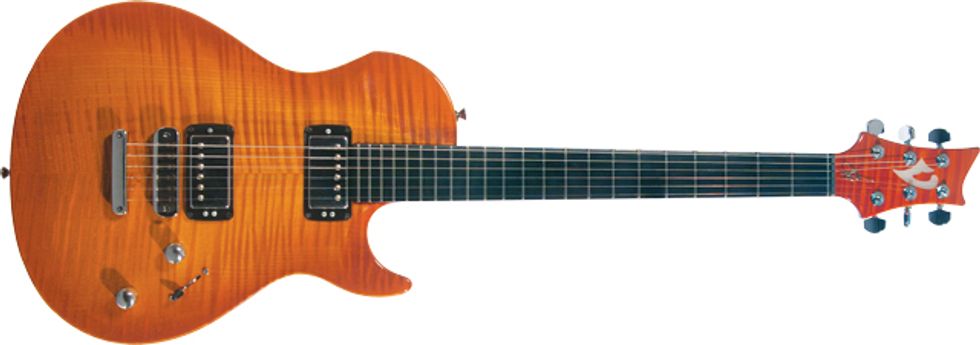
VIGIER
GUITARS G.V.
WOOD
France’s Vigier Guitars is renowned for
uniting evolutionary design with style that’s
at once individual and rooted in cherished
visual motifs. There’s certainly a whole lot
of Les Paul and PRS-style cues evident
in the G.V. Wood, yet this guitar is really
about the details and the sonic dividends
derived from attention paid to little things.
The slick, phenolic, resin-based fretboard is a string bender’s dream, even if it’s a tad hyper at times. The amber body is light and balanced, and the coil-tappable Amber pickups pack tone options for days. Reviewer Jordan Wagner remarked that the G.V. Wood “feels like a guitar for every occasion,” adding that “it yields a beautiful, full-spectrum signal that’s exceptionally responsive to touch.” Given how this guitar reminded all of us how you can still refine the familiar into something spectacular, it was a no-brainer to bestow the G.V. Wood a Premier Guitar Award.
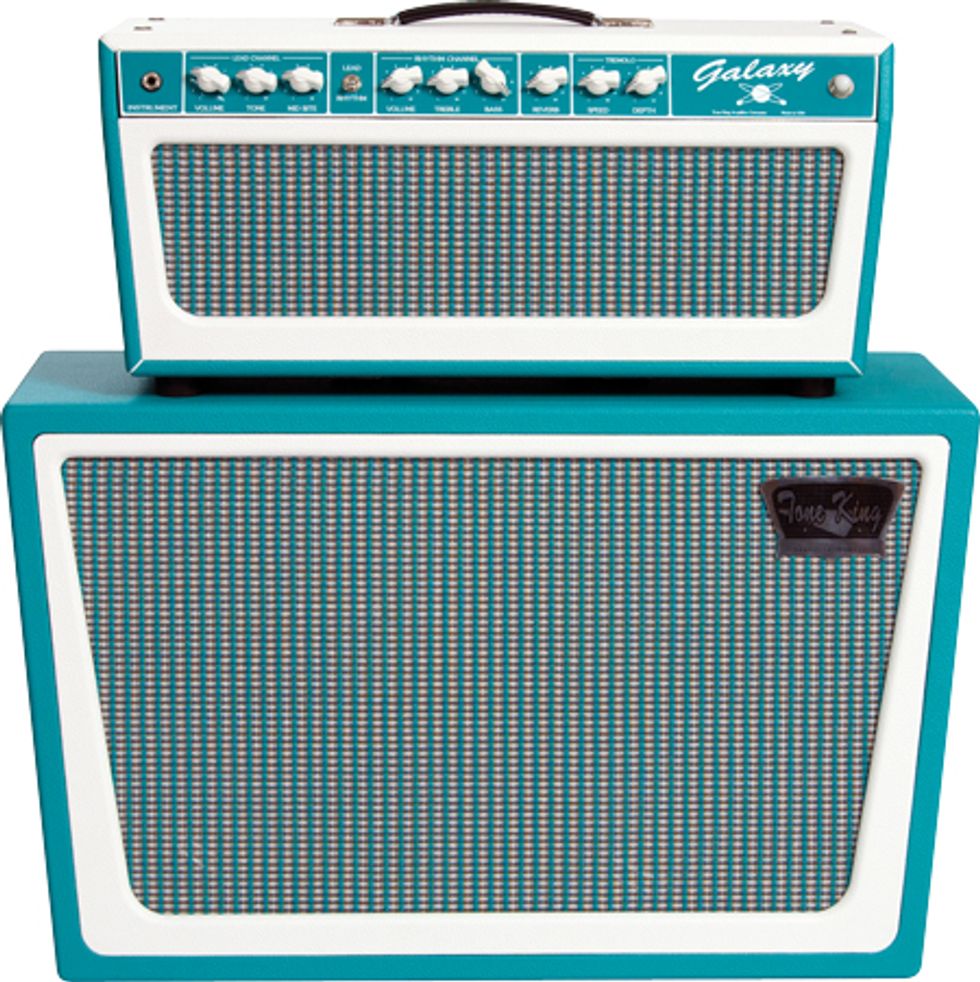
TONE KING
GALAXY
There could easily be a “Coolest Looking
Amp” award set aside for whatever
Tone King brings out in a given year, but
there isn’t. The reason the Galaxy received
a Premier Gear Award in 2011 is because
this swingin’ 60-watt, 6L6-powered bachelor
pad fixture sounds crazy sweet on top
of looking fit for the Dean Martin Go-Go
combo that never was.
Premier Guitar found it capable of everything from “surf-able cleans to biting blues,” and was driven to qualify the output as some of the cleanest, punchiest, most harmonically rich tones we’ve ever encountered. The onboard attenuator makes it truly usable as a sonic living-room fixture. But we also found it “blisteringly loud” and ready for the stage. It was just about impossible to find a flaw in construction anywhere. Did we mention it looks cool? Dang!
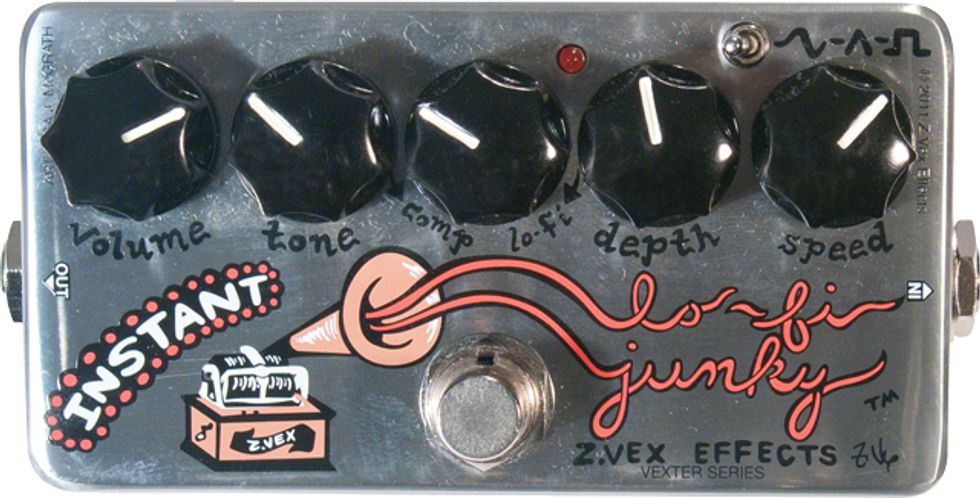
Z. VEX INSTANT
LO-FI JUNKY
It gives us great faith to see how far Z. Vex
has come while indulging such sick pedaldesign
impulses. The Lo-Fi Loop Junky
was one of the most glorious symptoms of
the illness. And with the new Lo-Fi Junky
(which takes the looper, if not the loopy, out
of the equation), Z. Vex has consolidated
some of its more delightfully obscene tones.
We could talk tech about how compression and vibrato combine to create its reality- twisting sounds and more mellow and unique textures. But what matters is that this is a ticket to a truly new Tonelandia if you’re willing to buy a ticket. From chorus to wacky warble to a compression that reviewer Jordan Wagner called “staggeringly good,” this is one twisted genius of a pedal.

FRET-KING
SUPER-MATIC
Some of us don’t mind too terribly if our
guitars sound like they were tuned by a
sleep-deprived member of the Kingsmen
from time to time. Most of us, however,
like to tune a lot and prefer that our guitars
stay that way. And others have the nerve to
prefer alternate tunings that stay in tune,
which no matter how you size it adds up
to a whole lotta peg-twisting. That reality
apparently got guitar innovator Trev
Wilkinson thinking. The result is the Fret-
King Super-Matic, a self-tuning marvel that
really works in standard and alternate tunings
alike.
The real magic of the Super-Matic is the latter capability. It makes the guitar a real solution to the guitar-that-can-doit- all dilemma, if that’s your concern. Features like the Vari-coil pickup coilsplitting system and the fact that you can store your own preset tunings make this a guitar you can personalize for a multitude of situations.
fret-king.com
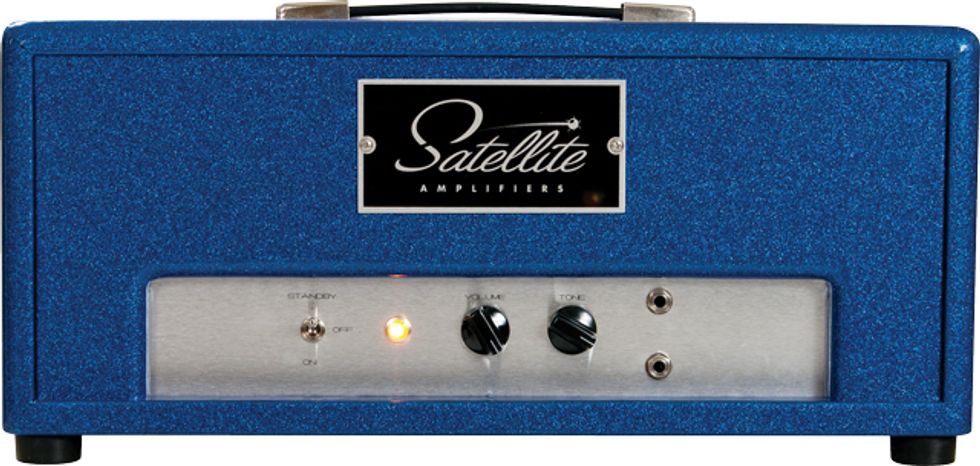
SATELLITE
MUDSHARK
There’s no shortage of fools that have gone
in pursuit of Jimmy Page’s Led Zeppelin I
tone, forgetting that it was a combination
of studio wile, an all-analog studio signal
path, and a certain set of magical, genius
fingers interfacing with a mind open to
wildly divergent influences. Even still,
Satellite Amplification did us mortals the
favor of resurrecting one of the most vital
components of the equation—a beautiful
take on Jimmy Page’s Supro Thunderbolt
cheekily dubbed the Mudshark.
This dead-simple, 5881-tube powered, 20-watt, blue sparkle meanie, is a thing of minimalist beauty. And we discovered that it can very stylishly move from wellmannered to malevolent, finding that it “remains defined during complex chord work, and exhibits pick sensitivity that we have rarely experienced in an amplifier. It’s very honest, with beautiful grit and nary an ounce of dampening or over-compression.”
It may not get you all the way to “Dazed and Confused,” but it can get you part of the way in style and perhaps open up some unexplored facets of your own playing along the way.
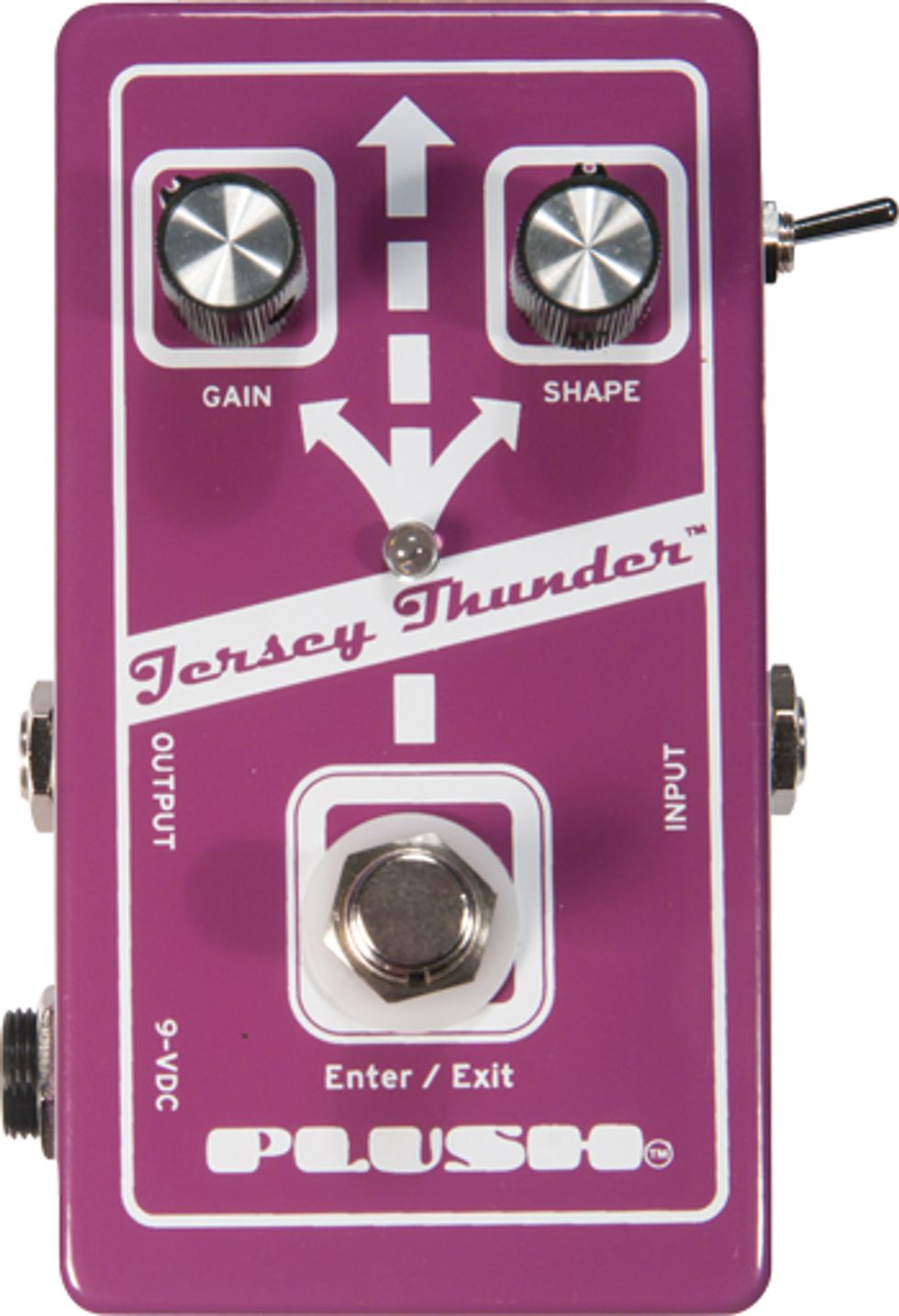
FUCHS
PLUSH FX
JERSEY
THUNDER
Andy Fuchs’ Plush line of effects have been
turning up with ever more regularity on the
pedalboards of frontline guitar rippers. If
the Jersey Thunder is any indication, bassists
will soon be falling in line—especially if, as
reviewer Jordan Wagner observed, the Jersey
Thunder can summon frequencies from
your bass you may not have even known
were there.
Like so many Fuchs products, from amps to pedals, the Jersey Thunder seems built with an ear for touch sensitivity. The versatile Shape control moved Wagner to comment on how he could summon punch without loss of clarity. He found the Slope EQ settings “perfectly tuned.” Little surprise, perhaps, given that Andy Fuchs is behind it all—but maybe a revelation for bass players in waiting.
BREEDLOVE
GUITARS
FOCUS SE
CUSTOM
WALNUT
Breedlove built its rep’ on top-quality
guitars that walked just a little off the
beaten path. The Focus SE Custom Walnut
couldn’t do a better job of holding up that
tradition. With walnut back and sides and a
redwood top, it’s a beautiful deviation from
bread and butter tonewood combinations.
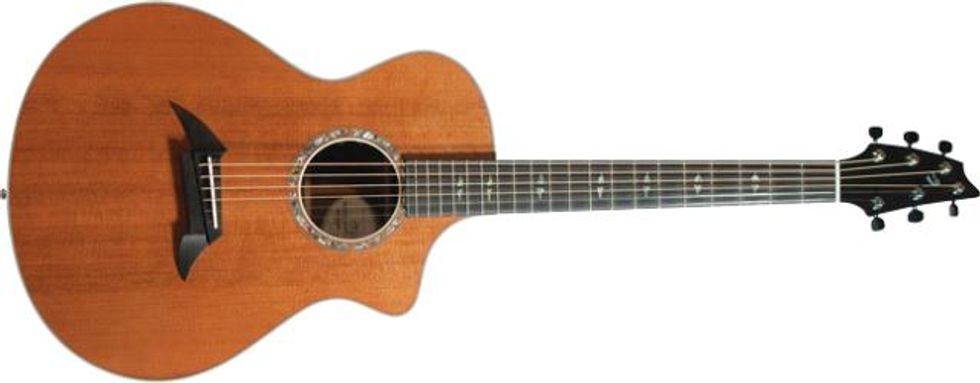
The result, as reviewer Gayla Drake Paul noted, is a guitar that’s “simultaneously dark and brilliant, thanks to the snappy-but-deep qualities of the walnut back and sides— which sound a bit like a cross between rosewood and mahogany—while the redwood has the warm detail of cedar.” Gayla also loved its rich and varied personality: “it’s quite loud, projects extremely well, and is responsive to a light touch—all of which translates to great dynamic range. Play it whisper-soft and you’ll get a crystalline, delicate tone. Dig in, and the Focus SE rocks without significantly blurring overtones.”
We also noted it’s a guitar that “gorgeously illustrates how Breedlove has helped bridge forward-thinking and old-world styles.” We’re thankful that Breedlove still knows how to walk that walk.
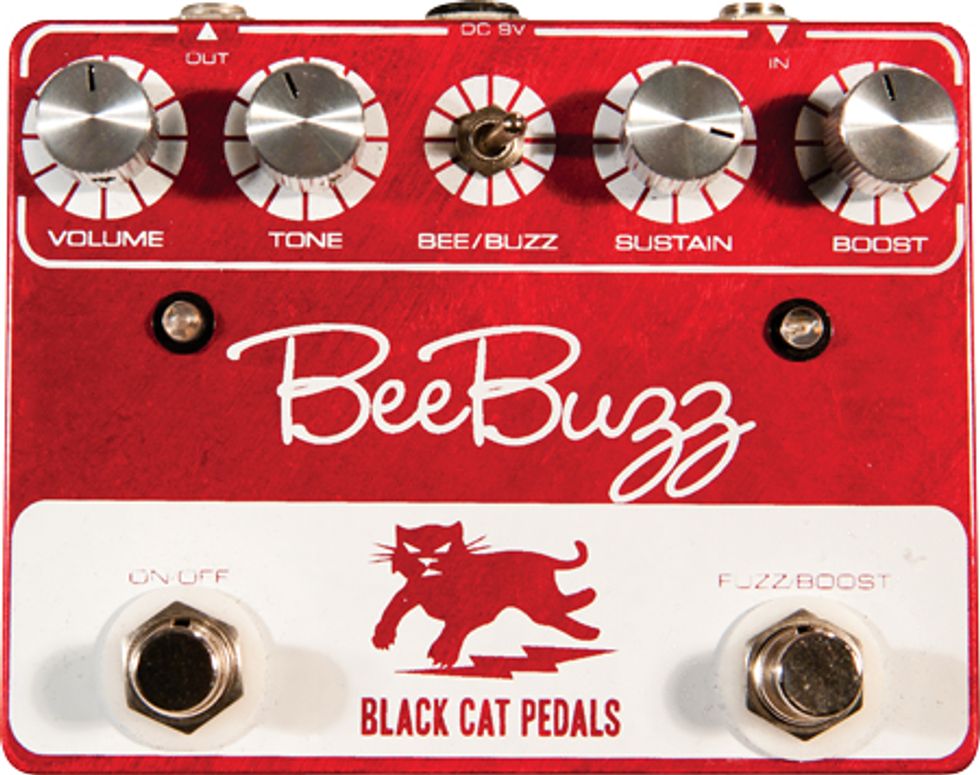
BLACK CAT
BEE BUZZ
In tackling a re-interpretation of the underground
legend that was and is the Roland
Bee Baa, Black Cat not only gave new life
to one of the great unsung fuzzes, but lent
some of its own twists that make it a standout
in a cluttered cosmos of buzz ‘n’ fuzz
boxes.
The strength might be a beautifully skuzzy, but surprisingly meaty, ’60s-style fuzz in Bee mode, a switch to Buzz mode rendered our candy apple Bee Buzz a brawny cousin to the Fuzz Face and Big Muff clans.
Gear Editor Charles Saufley was moved to gush that the “Bee Buzz is a brilliant beam of stinging light in the world of brawny, super high-gain fuzzes,” and that “with the flip of a switch it transforms into a meatier Muff-like fuzz that can run with those tigers, too.” For those who don’t mind risking the sting, the Bee Buzz is one burly little bugger that can rise above the din.
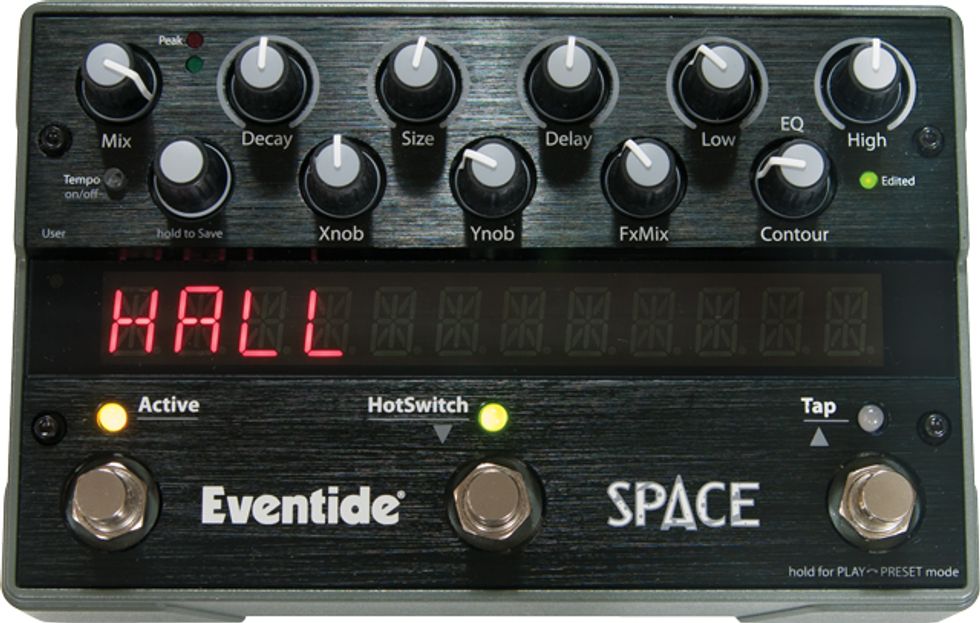
EVENTIDE
SPACE
Rarely has such an ambitiously named piece
of gear lived up to its handle. No joke, this
little box really can sound like the whole
freaking cosmos in all its exploding, nebulous
glory. It’s a pretty nice straightforward
reverb, too, if that’s your need or fancy. But
smart and free-ranging players will take
advantage of all its multitudinous capabilities,
and will no doubt make some very
interesting music.
Space does its magic by spinning out sonic tangents from 12 basic reverb algorithms, including Hall, Room, Plate, Spring, and Reverse and more esoteric algorithms like Mangledverb (distorts and detunes reverb tails), Shimmer (shifts pitches in reverb tails and lends a touch of harmonizing), and Blackhole (lends an overtone-rich, morespacious- than-space feel).
The latter is a particularly apt descriptor because this Eventide can truly be a Black Hole for practice time. Few pedals have ever made a single D chord so cool in so many ways. Those who care to venture further into the ways it will interact with more nuanced playing risk never returning. Like the universe itself, Space is virtually endless. If you go, don’t forget to write.
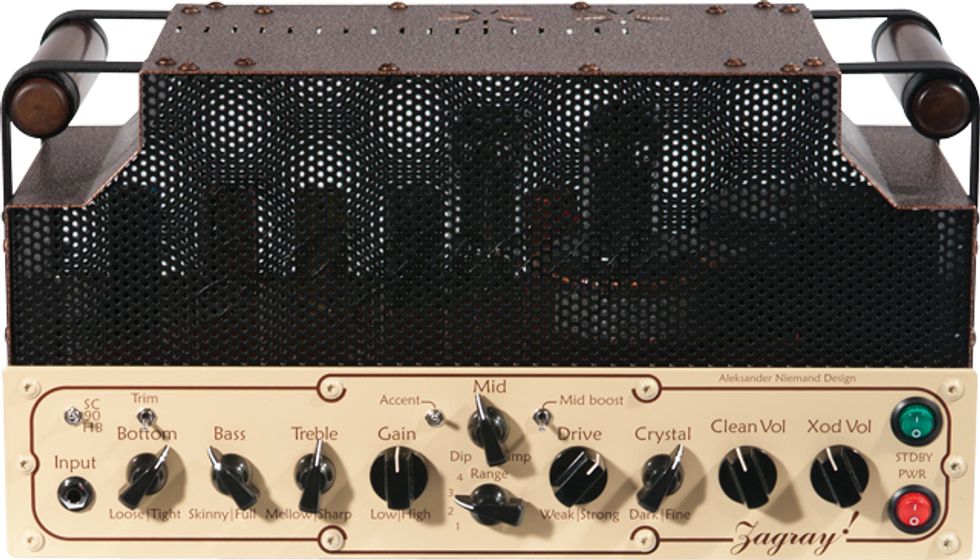
ANACON
TECHNOLOGY
ZAGRAY!
If you’re among the more visionary folk
who agree that an amp can look like something
other than a vinyl- and cloth-covered
fruit crate, the Anacon Technology Zagray!
is your white knight. It certainly won’t hurt
that it sounds amazing, too.
The 23-watt, 7591-powered head, which evolved very publically on forums, much to the delight of circuit nerds, was built by tinkerer extraordinaire Aleksander Niemand. While it looks like a handful, PG reviewer Steve Ouimette found the Zagray! quite capable of everything from simple clean Strat tones to Montrose- and ZZ Top-style crunch—praising a midrange voice that he claims “smokes just about every amp on the market.”
He was also very reluctant to let it go when Niemand needed it back, saying: “few amps I’ve played over the past few years offer the flexibility, performance, tone-shaping options and pure fun of the Zagray! If I had to choose a single studio amp for my work, this might be it.”
anacon-tech.com

DINGWALL
GUITARS Z3
5-STRING
We may not have moved along enough in
our musical evolution to require the extended
possibilities of things like fanned frets.
But when the time comes that a regular old
four-string is standing in the way of you
playing your best, the Dingwall Z3 5-String
is waiting to launch you to the next level.
According to reviewer Dave Abdo, you could sum the Dingwall in the words “versatile” and “balanced.” In fact, he “was able emulate the punch of a StingRay or the warm, plucky sounds of a jazz bass with a simple turn of the pickup selector.” No mean feat for a single bass.
The fan frets had Abdo counting himself as a convert in no time at all—finding the layout comfortable and intuitive after a spell. Most of all, he really came to appreciate that the Dingwall could do it all, from rockin’ moves that seemed almost incongruous to its advanced appearance, to the fancy fretwork it looks born for.
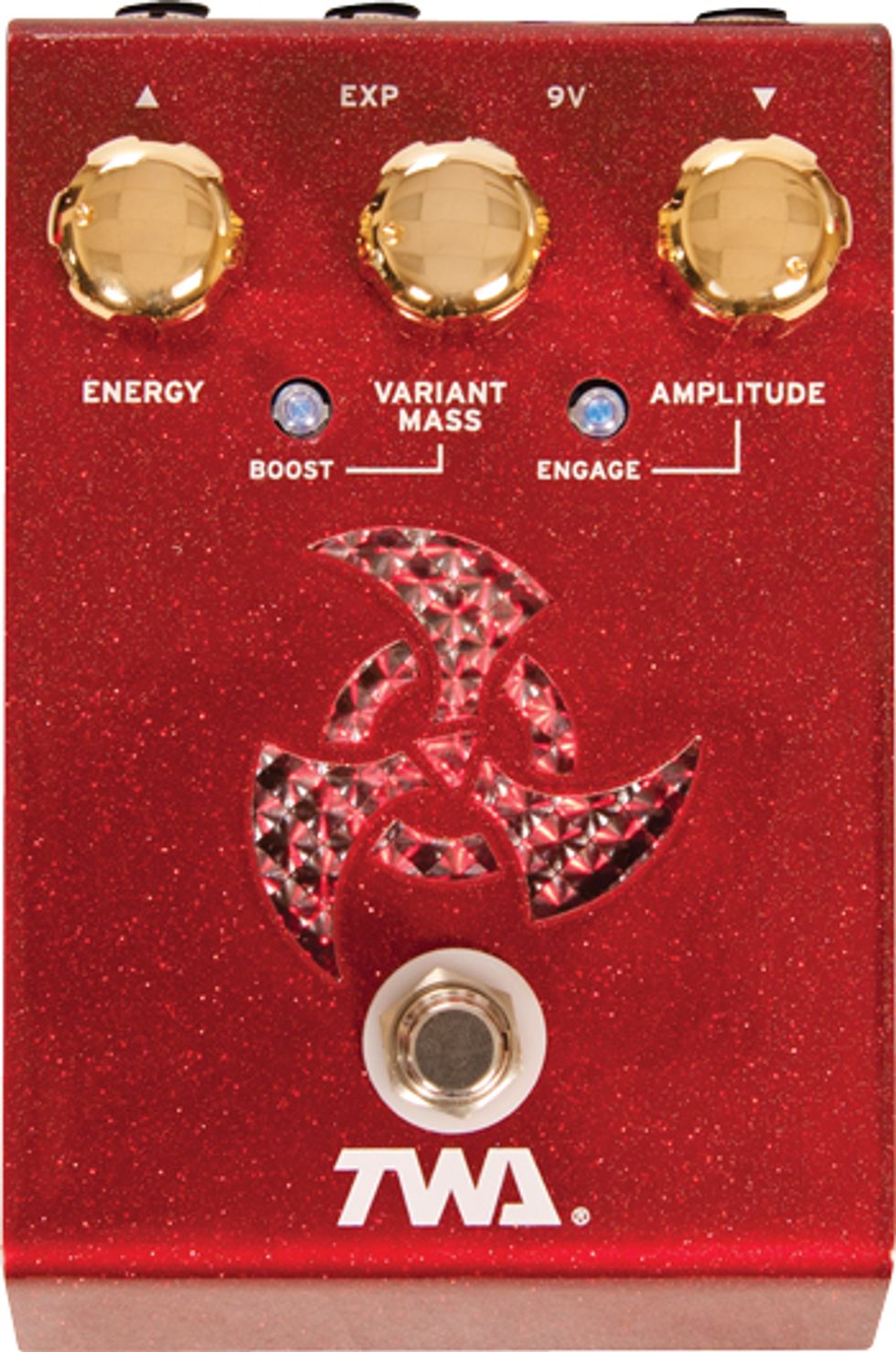
TOTALLY
WYCKED AUDIO
TRISKELION
TK-1
HARMONIC
ENERGIZER
If the Totally Wycked Audio Triskelion
TK-1 looks more than a little like an instrument
sent across space by some sinister
Klingon-ian kingdom to do harm, well…
it kinda is. Inspired in many ways by the
Maestro Parametric Filter and Systech
Harmonic Energizer, it’s a filter that boosts
and modifies specific frequencies—often in
radical ways.
The TK-1 proved to be a multi-dimensional weapon. And we noted that it was easy to set the Triskelion to take advantage of a guitar’s given strength, hone in on the harmonic sweet spot of a guitar or pickup and boost it. But as its aggressive visage suggests, it’s just fine with getting mean, and we were moved to remark that it’s “graceful and at home when heavy, and will drag you and your guitar happily screaming in pursuit of lingering notes and harmonics.” Clean or dirty, we found lots of reasons to love the TK-1. For bringing so much life to our axe work in spite of its Wycked appearance, we felt it most deserving of a Premier Gear Award.
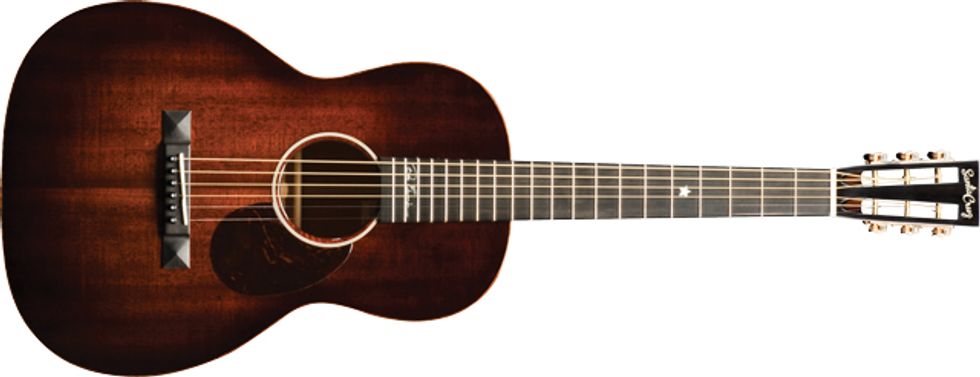
SANTA CRUZ
DON EDWARDS
COWBOY
SINGER
Acoustic guitars don’t get much prettier—or
prettier sounding—than this. Santa Cruz’s
Don Edwards Cowboy Singer honors one of
America’s genius cowboy poets, but it’s also
about the nicest interpretation of the classic,
all-mahogany Martin 00-17 that you’re
likely to see.
Like so many Santa Cruz guitars, the Cowboy Singer oozes with understated luxury. And while it may be inspired by a classic, it has a personality all its own. Gear Editor Charles Saufley remarked, “the Santa Cruz has a dimension, brightness, and crystalline tone that you could safely call uncommon for this tonewood recipe.
He also noted “the fact that Santa Cruz gets such a wide spectrum of sound and projection out of a small-bodied mahogany acoustic speaks volumes about Hoover’s extra-mile manufacturing methods, which include thin nitrocellulose finishes and timeconsuming, tap-tuning of tops. And the payoff comes in the form of an extremely dynamic, touch-responsive guitar that can gracefully accommodate stylistic shifts.” A sweet singer to be certain.
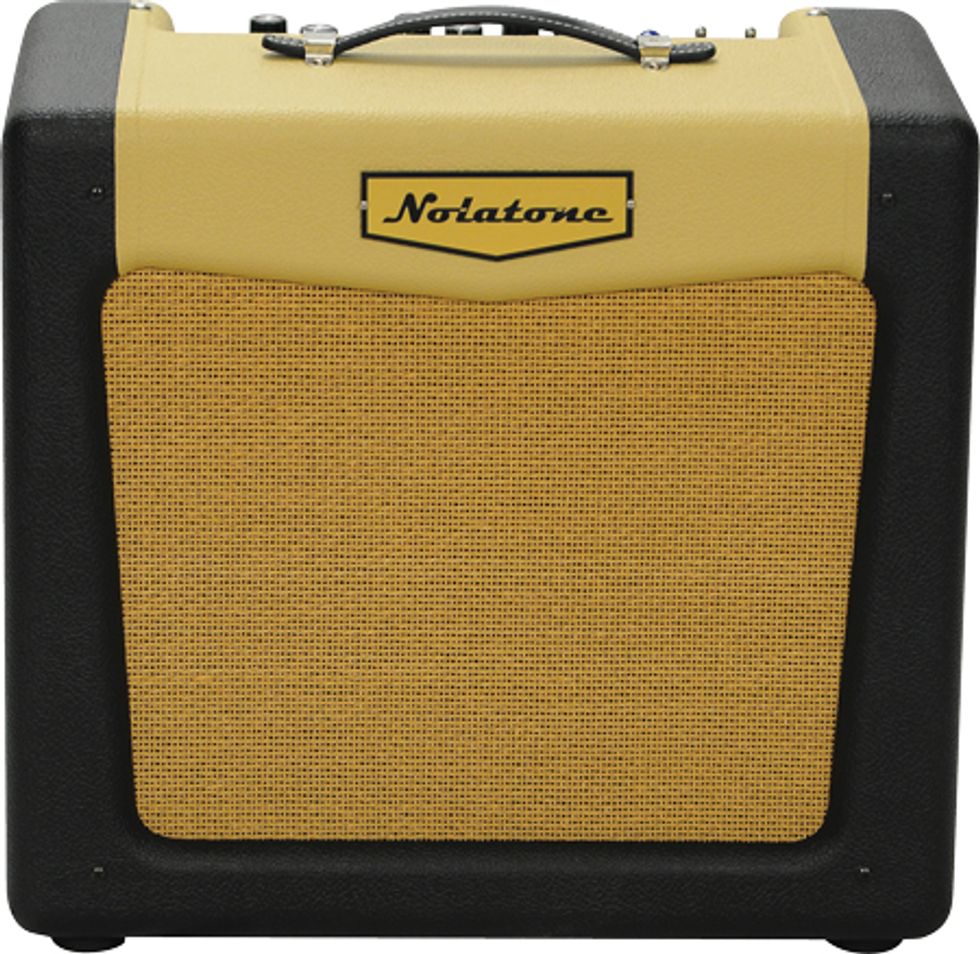
NOLATONE
AMPWORKS
ROTTEN
JOHNNY
The Nolatone Rotten Johnny was in the
running for the prettiest amp we saw all
year. The beauty went more than skin
deep. The 15-watt, 12" speaker equipped,
6V6-powered amp proved to be quite
capable of clean and nasty tones thanks to a
well-designed control set and circuit.
Reviewer Steve Ouimette was prompted to remark that “the Rotten Johnny doesn’t lack headroom. Because there is so much control via Pre and Post gain over how hard you hit the tubes, I found myself digging deep into the wealth of Strat-friendly clean sounds you can get with less aggressive use of those controls.”
On the flip side, Ouimette noted that he “was able to dial in AC/DC rhythm tones with just the right amount of kerrang and chime to create the illusion of a blaring baby JTM45.” All that and a cabinet that drove many of us to drool, left us little choice but to bestow a Premier Gear Award.
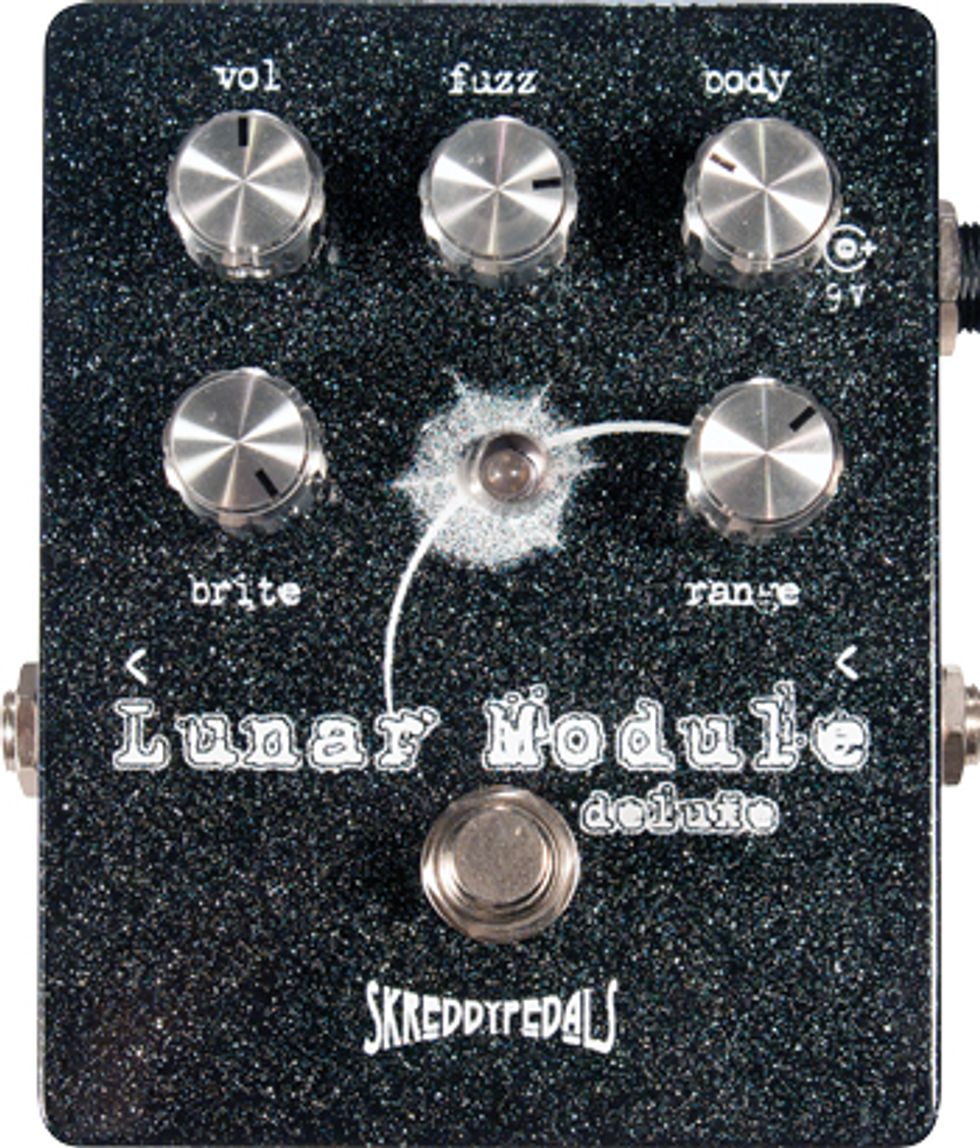
SKREDDY
PEDALS
LUNAR
MODULE
DELUXE
The cult of Gilmour is a mighty army. It
even has a team of engineers dissecting his
tone around the clock—picking it apart
down to the very last brick in the wall, so
to speak. Sometimes they yield discoveries
for the rest of us. Take the Skreddy Lunar
Module Deluxe—unabashedly created to
transport us to the microgrooves of the
Dark Side of the Moon LP, but also a fuzz of
wild flexibility.
Reviewer Joe Charupakorn was quick to note how beautifully the Lunar Module Deluxe tamed the more temperamental side of silicon Fuzz Faces like Gilmour’s. He further observed that the Skreddy “gives the player even more control over this notoriously hairy circuit with a variable-gain input transistor, as well as a tone control for added brilliance that’s helpful for tailoring the pedal to different guitars and amps.” Great for Gilmour-heads, but a sweeter Fuzz Face clone for the rest of us, too. Meet you on the dark side, then?



























































